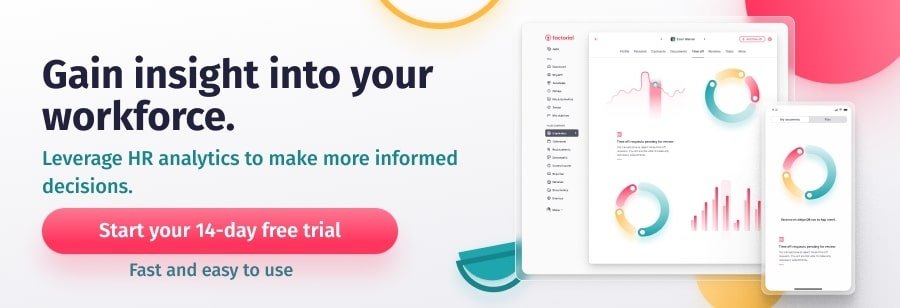As an employer, have you ever sat down and calculated your revenue per employee? Do you know if your organization is getting the most from your workforce? Not all employers are aware of the importance of this HR metric, but it is a clear indicator of how healthy your business model is.
For example, did you know that, according to Statista, leading tech giant Netflix generated over 2.34 million U.S. dollars of revenue per employee in 2019? Pretty impressive, right? Although this figure is way beyond what most organizations can hope to achieve, it’s still important to know how to quantify the efforts of your staff.
With this in mind, let’s take a look at how to calculate the average revenue per employee. We’ll discuss what your revenue per employee benchmark should be, and the average revenue per employee by sector to help you see what you should be aiming for.

What is Revenue per Employee?
Revenue per employee (RPE) is an HR KPI used to calculate a rough estimate of how much money each employee generates for the company. You do this by measuring the total revenue that your organization generates over a given period (usually a year), then divide this figure by your current number of employees.
There are a number of reasons why it’s a good idea to calculate this metric on a regular basis.
For example, you can:
- Compare revenue per employee year-on-year to see if there are any notable changes. For instance, it can help you understand the impact of your attrition rate on ongoing performance.
- See how your RPE compares to your competitors.
- Determine the efficiency and productivity of the average employee at your company.
- Measure the efficiency of your revenue model and see how well you are using your human capital (the higher the ratio, the more productive your employees are).
- Track the performance of your employees (the lower the ratio, the more likely you are to experience losses such as an unexplained high turnover rate and increased labor costs)
- Evaluate any historical changes within your organization so that you can make improvements to your structure and operations and encourage growth and profitability through the right hiring practices, training, and retention programs.
Revenue per Employee Formula
The revenue to employee ratio is one of the most universally accepted human resources KPIs for calculating how much revenue your average employee generates for your business.
The formula is as follows:
Revenue per employee = Revenue / Current number of employees
Revenue per employee is usually measured against your total revenue for the last twelve months (LTM). However, if you want to calculate your revenue per employee for a different time period (e.g., quarterly, bi-annual), then you just need to adjust the appropriate time period when extracting your data.
You could even expand this calculation by working out your Full-Time Equivalent (FTE) ratio. This is an indicator that reflects an employee’s productive capacity. Calculating your FTE will help you identify whether your small business needs to hire, restructure or reduce its staff.
How to Calculate Revenue per Employee
We’ve looked at the formula for calculating your revenue per employee, so now let’s take a look at a couple of examples to help you understand how it works.
Example A:
Autoparts ABC creates replacement parts for cars and trucks. The company generated $80,000 annual revenue last year, and during this period the organization had a total of 40 employees.
So, we just need to divide the annual revenue, by the total headcount for the same period, as follows:
$80,000/40 = $2,000 Revenue Per Employee
Example B:
Google’s parent company Alphabet reported $257 billion in revenue for 2021. The company had 156,500 full-time employees during this period.
So, again, we just need to divide the annual revenue, by the total headcount for the same period, as follows:
Google revenue per employee: $257 billion / 156,500 = $1.65 million revenue per employee
What is a Good Revenue per Employee Ratio?
Generally speaking, the higher your revenue per employee, the more productive your employees are, and the more profit you will make as an organization. A high RPE also suggests that you are using your human capital resources wisely by developing the right employees.
A good revenue per employee benchmark ranges between $43,000 and $230,000 per employee. However, as we saw with the examples above, your RPE will depend on the size and nature of your company. You can’t compare the RPE for a company like Autoparts ABC with that of Google’s parent company Alphabet. RPE also varies by industry, as we will see in the next section.
The best way to determine if you have a good RPE is to conduct market research to see how you compare with your competitors. That will help you determine if you need to make any adjustments in order to help your employees become more productive and efficient.
Revenue per Employee Benchmark by Industry
As we just mentioned, revenue per employee also varies greatly depending on your industry. You need to take this into consideration when you establish your revenue per employee benchmark.
The average revenue per employee by industry:
- The energy sector has the largest revenue per employee by far, with an average RPE ratio of $800,000.
- Software and technology companies have an average revenue to employee ratio of $400K.
- Financial companies have an average RPE of $78,073.
How to Increase Revenue per Employee
When it comes to increasing RPE, the first step is knowing where you stand. This will give you a benchmark to measure your progress. This means using the right KPI template, HR benchmarks and predictive analytics HR software to monitor your metrics. You can start by downloading this handy free KPI Excel to help you identify key performance indicators in your company.
Once you’re comfortable with that, you might decide to take it a step further and implement an HR dashboard to create custom HR management reports and streamline all your data. Having the right data to hand will make it much easier to identify what you need to work on in order to increase your RPE. It gives you the tools you need to design a strategy for success.
In terms of strategy, according to a report by Gallup, there are four human capital strategies that, when combined, can help you add up to 59% more growth in revenue per employee.
Let’s finish by taking a look at these four human capital strategies.
Recruit the Right Managers
This is perhaps the most important strategy when it comes to increasing your RPE, as the quality of your managers has the biggest influence on the quality of your overall workforce. With the right managers in place, you are far more likely to attract and engage talented employees. In fact, studies have shown that a talented manager can achieve 27% higher growth in revenue per employee.
An effective manager should know how to drive positive outcomes and build strong relationships within their team. They should be good listeners, have empathy, and be supportive. They should also know how to make decisions based on performance and understand how to guide employees effectively.
Although experience and qualifications are important, make sure you look out for all these soft skills when you recruit your managers. If you don’t already have one, download our free hiring process checklist to make sure you keep track of all recruitment needs. Plus, the more efficient your recruitment process is, the quicker your time to hire will be!
Develop Talented Employees
Ok, so you’ve recruited your top managers, now what?
Well, the next step in increasing your RPE is getting those managers to develop talented employees. This means offering your employees the right learning opportunities so that they can develop into productive, engaged, and motivated members of staff. Make sure you invest in L&D so that your employees have the right support in order to become talented employees.
Nurture an Engaged Workforce
It’s also important to nurture an engaged workforce. If your employees don’t feel motivated and inspired, then they will almost definitely not be working at full capacity.
Did you know that disengaged employees are estimated to cost the U.S. between 450-550 billion dollars per year? And this has a direct impact on your RPE.
Focus on building a culture of engagement. Develop a strategy aligned with communication and accountability, and regularly track the right people analytics (how engaged individuals are) and workforce analytics (how engaged your overall workforce is) so that you keep your finger on the pulse.
Focus on Strengths
Finally, the best way to increase your revenue per employee is to focus on strengths and encourage continuous improvement. Check in regularly with all your employees and offer support when needed. By focusing on developing strengths, rather than criticizing weaknesses, your employees will feel more engaged and supported. And this will have a direct impact on their performance and productivity, boosting your bottom line.

